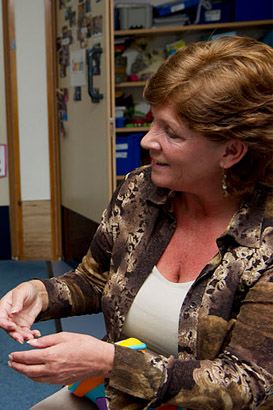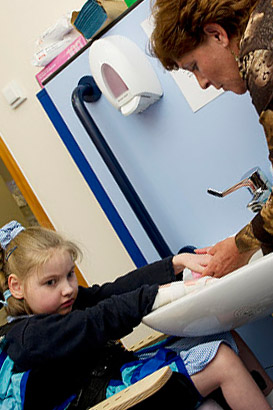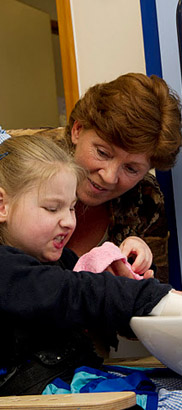
...for those who are likely to remain...at or below P3...,
the National Curriculum on its own, or even as the basis for a curriculum document, ...is of limited benefit. Similarly, assessment
models such as P Scales or variations of this (Pivats and 'B' Squared being the most common) which use linear developmental
progression, come nowhere near to explaining or doing justice to the real progress and development which we know that those
with PMLD can make.
Crane, 2010
Read the following article on the latest developments in curriculum design for pupils with PMLD.
Lacey, P. (2009) 'A profound challenge', SEN Magazine, (December).

A key aspect of the role of the class teacher working with SLD/PMLD/CLDD pupils is to ensure that their pupils' academic, social, emotional and physical care needs are met effectively on a daily basis.
Using time effectively by integrating personal care and curriculum delivery is an essential skill. It requires careful planning and effective team deployment on a day-to-day basis to maximise learning opportunities and ensure a high quality of care.
Decisions are likely to be driven by practical considerations (eg pupil to staff ratio, location of changing facilities, moving and handling risk assessments), teacher/school preferences, age and needs of pupils.

Common approaches to integrating curriculum delivery and personal care are:
- The teacher leads curriculum activity with pupils being withdrawn for personal care as appropriate by class team support staff.
- The whole class team works in rotation to meet care needs then move into curriculum activity.
- The school employs a group of staff primarily to withdraw pupils to meet their care needs.
For a description of how approach three works in practice, read this document.

Schools usually address integration through the priority given to the PSHE curriculum. Have a look at these sample school statements about the role of PSHE and its link to the curriculum.
- What do you see as the key themes running through these statements?
- What are the challenges of such an approach in the context in which you have experience?
Compare your answer with the sample answer below.

Class teachers integrate personal care within the academic curriculum differently. One approach is to construct individual timetables which sit alongside the class timetable.
- Start with a timetable outline.
- Allocate times for personal care (eg for changing, preparing for home) from your knowledge of the child or young person.
- Look at how to integrate this with the academic timetable to maximise curriculum access, and adjust as necessary.
- Consider when therapeutic interventions can be delivered (eg daily time in a standing frame during a music activity, side-lying during an art activity, individual PECS communication planned into a science session).

Look through these different examples of school and individual timetables:
Think about a child that you know (or one of the examples given above) and consider what proportion of their school day you would expect to spend on:
- Personal/medical care.
- Therapeutic interventions.
- Academic learning.
How could you organise class staff to deliver this timetable?
Environments can help maximise children and young people's learning, and support independence in medical/personal care. Occupational therapists can advise on the design of space and possible specialist equipment.
Important considerations are:
- The physical accessibility of all areas of the building including bathroom and dining areas. This includes designs for appropriate storage, accessible heights and proximity to teaching and learning areas.
- Secure site boundaries so that children and young people can be independent within a defined secure space.
- The maximum use of enabling technologies.
- An ethos in which staff assess and manage risk to promote independence.
Have a look at this case study.

Qualifications and Curriculum Authority (2009) Planning, Teaching and Assessing the Curriculum for Pupils with Learning Difficulties: Personal, social and health education and citizenship. London: QCA.
Qualifications and Curriculum Authority (2009) Planning, Teaching and Assessing the Curriculum for Pupils with Learning Difficulties: Developing skills. London: QCA.

Crane, M. (2010) Greenfields' school curriculum document for pupils and students with profound and multiple learning difficulties (PMLD). (adapted from The Bridge School PMLD Curriculum).
Welsh Government (2006) Routes for Learning. Cardiff: Welsh Government.